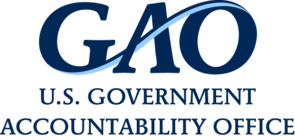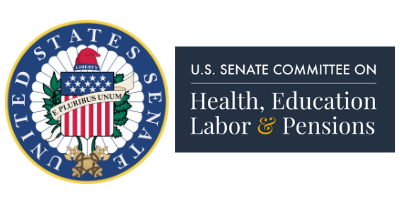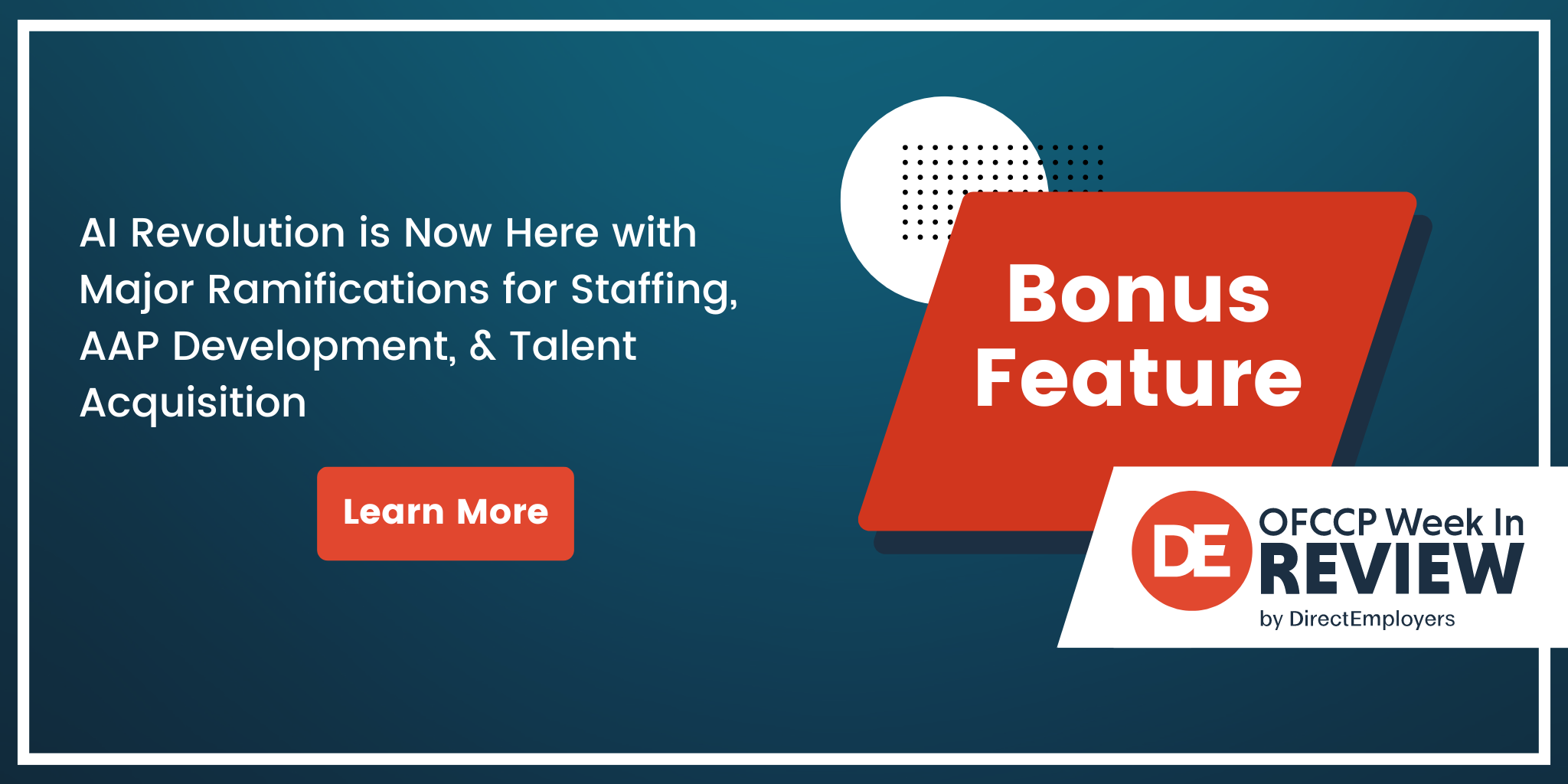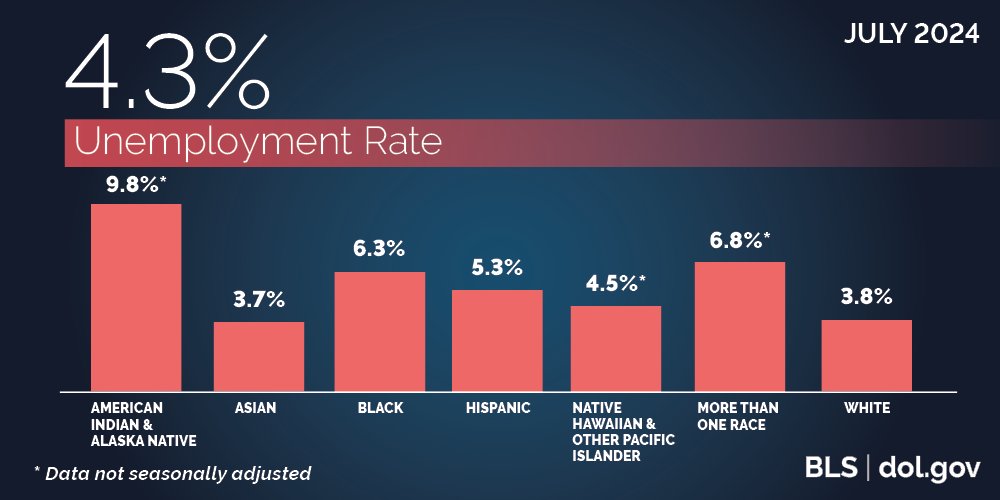
- U.S. GAO Published Report on Federal Agencies’ Management of Human Trafficking Risks in Contracts
- JOLTS Report – Job Openings Decreased by 46k in June, Rate Held Steady at 4.9%
- AI Revolution is Now Here with Major Ramifications for Staffing, AAP Development, and Talent Acquisition
- Massachusetts Enacted Bill That Requires Pay Ranges in Job Ads & Worker Data Reporting
- Job Growth Slowed as U.S. Economy Added Only 114k Jobs in July, Unemployment Rate Edged Up to 4.3%
- In Brief
- New Publications
- Looking Ahead: Upcoming Date Reminders
Tuesday, July 30, 2024: U.S. GAO Published Report on Federal Agencies’ Management of Human Trafficking Risks in Contracts
GAO Found Agencies Need to Adopt a Systematic Approach to Manage Risks in Contracts

How Does the Applicable Law Define “Human Trafficking”?
The Federal Acquisition Regulation (“FAR”) – at Subpart 22.17 – implements the Federal Property and Administrative Services Act (40 U.S.C. 101 et seq.), the Trafficking Victims Protection Act of 2000, as amended (“TVPA”; 22 U.S.C. 78, Division A), and President Obama’s Executive Order 13627 of September 25, 2012. These laws all apply the definition of “severe forms of trafficking in persons” (“trafficking” or “trafficking in persons”) contained in Section 103 of the TVPA (22 U.S.C. 7102(8)), to include (1) “sex trafficking in which a commercial sex act is induced by force, fraud, or coercion, or in which the person induced to perform such act has not attained 18 years of age,” or (2) “the recruitment, harboring, transportation, provision, or obtaining of a person for labor or services, through the use of force, fraud, or coercion, for the purpose of subjection to involuntary servitude, peonage, debt bondage, or slavery.”
Application to Federal Contracts
The Report (at pdf pages 5-6) explains that:
“[t]he FAR implements U.S. policy prohibiting trafficking activities in acquisitions through requirements for awareness, compliance, and enforcement to prevent trafficking in or related to government-funded contracts. Since 2007, it has required all U.S. government contracts to include a clause prohibiting trafficking. In January 2015, the FAR Council amended the FAR clause to clarify prohibited practices. The FAR now requires prime contractors to establish and adhere to an anti-trafficking compliance plan for certain contracts and ensure that subcontractors and agents do so as well. An agent is any individual authorized to act on behalf of the organization, including a director, an officer, an employee, or an independent contractor.” [citation omitted]
What Did the Report Find?
GAO focused its Report on four agencies that it identified as having significant contract spending or heightened risk of trafficking – the Departments of Homeland Security (“DHS”), Defense (“DOD”), and State and the U.S. Agency for International Development (“USAID”).
On October 21, 2019, the White House Office of Management and Budget (“OMB”) issued a memorandum, Anti-Trafficking Risk Management Best Practices & Mitigation Considerations, to enhance the effectiveness of anti-trafficking requirements in federal acquisition. In response to that memorandum, three of the four agencies DHS, DOD, and State have taken initial steps to identify trafficking risks in their contract spending. However, USAID did not conduct the analysis that OMB recommended. Further, none of the four agencies have taken a systematic approach to managing trafficking risks in contracting, GAO found. Such an approach would include identifying and analyzing, developing responses to, and communicating the risks to contracting officials. This approach would better position agencies to support the U.S. policy of zero-tolerance for human trafficking, the GAO concluded.
Inconsistent Compliance with Anti-Trafficking Requirements
For the Report, GAO reviewed a nongeneralizable sample of 12 contracts awarded in fiscal years 2022 and 2023 by the four agencies. GAO reviewed the contract files for documentation related to federal and agency anti-trafficking requirements. GAO also reviewed relevant statutes, federal and agency regulations, guidance, and training, and interviewed OMB and agency officials.
All four agencies communicated federal anti-trafficking requirements to contracting officials through training and guidance, GAO found. Further, most contracting officials GAO spoke with had completed the training and were aware of how they should report trafficking violations. However, compliance with requirements was inconsistent. Specifically, GAO found that nine of the 12 contracts it reviewed did not meet one or more of the anti-trafficking requirements, such as obtaining a required anti-trafficking certification from contractors.
Although agencies require certain contractors to develop an anti-trafficking compliance plan, contracting officials are not required to request the plans, the GAO pointed out. Moreover, GAO found that four of the six plans provided by contractors did not meet all federal requirements for what must be included in a compliance plan. Reviewing implementation of, and compliance with, federal anti-trafficking requirements in contracts would help to assure agencies that contracting officials and contractors are fulfilling their responsibilities to prevent trafficking in federal contracts, GAO concluded.
In addition, GAO reported that suspension and debarment offices at all four agencies said they received no referrals of Inspector General-investigated trafficking allegations against recipients of contracts, grants, and cooperative agreements for fiscal years 2022 and 2023. The DOD Inspector General reported conducting investigations into trafficking allegations during this time. Contractors also reported taking actions against subcontractors that violated their anti-trafficking policies.
Nine Recommendations
The GAO made a total of nine recommendations, including two each to DHS, DOD, State, and USAID; and one to OMB. They are:
(1) The Secretary of Homeland Security should ensure that the Chief Procurement Official, in consultation with agency trafficking experts, establishes a timeline for and implements a systematic approach to managing trafficking risks in procurements. This approach should include:
- identifying and analyzing agency procurement-related trafficking risks for their level of trafficking risk,
- developing responses to address their highest risks, such as obtaining contractor anti-trafficking compliance plans and verifying contractor implementation of requirements, and
- communicating this information to contracting officials.
(2) The Secretary of Defense should ensure that the Under Secretary of Defense for Acquisition and Sustainment, in consultation with agency trafficking experts, prioritizes developing and implementing a systematic approach to managing trafficking risks in procurements. This approach should include:
- identifying the agency’s current trafficking risks and analyzing at-risk procurements for their level of risk,
- developing responses to address those risks, such as obtaining contractor anti-trafficking compliance plans and verifying contractor implementation of requirements, and
- communicating this information to contracting officials.
(3) The Secretary of State should ensure that the Deputy Assistant Secretary and Senior Procurement Executive, in consultation with agency trafficking experts, identifies a time frame to reevaluate whether the agency’s responses to contracting-related trafficking risks are working and if the agency needs to do a broader risk assessment.
(4) The Administrator of USAID should ensure that the Senior Procurement Executive, in consultation with agency trafficking experts, develops and implements a systematic approach to managing trafficking risks in procurements. This approach should include:
- identifying and analyzing procurements for their level of trafficking risk,
- developing responses to address those risks, such as obtaining contractor anti-trafficking compliance plans and verifying contractor implementation of requirements, and
- communicating this information to contracting officials.
(5) The Secretary of Homeland Security should ensure that the Chief Procurement Officer ensures components conduct reviews of a subset of contracts to determine whether contracting officials implemented federal anti-trafficking requirements, including incorporating the certification provision in covered solicitations and obtaining contractor anti-trafficking certifications prior to award and annually thereafter.
(6) The Secretary of Defense should ensure that the Under Secretary of Defense for Acquisition and Sustainment ensures components conduct reviews of a subset of contracts to determine whether contracting officials have implemented federal anti-trafficking requirements, including incorporating the certification provision in covered solicitations and obtaining contractor anti-trafficking certifications prior to award and annually thereafter.
(7) The Secretary of State should ensure that the Deputy Assistant Secretary and Senior Procurement Executive assess whether contracting officials obtained applicable annual contractor anti-trafficking certifications as part of the agency’s review of its awarded contracts.
(8) The Administrator of USAID should ensure that the Senior Procurement Executive reviews a subset of contracts to determine whether contracting officials have implemented federal anti-trafficking requirements, including incorporating the certification provision in covered solicitations and obtaining contractor anti-trafficking certifications prior to award and annually thereafter.
(9) The Director of OMB, in coordination with other agencies as appropriate, should clarify to agencies whether an entity’s annual Representations and Certifications in SAM.gov are sufficient to document contractor certifications related to combating trafficking in persons and determine whether there are any changes needed to SAM.gov.
Tuesday, July 30, 2024: JOLTS Report – Job Openings Decreased by 46k in June, Rate Held Steady at 4.9%

Hires, Total Separations & Quits. Layoffs/Discharges & Other Separations All Down
The number of hires in June was 5,341,000 compared to the adjusted 5,655,000 figure for May (-314,000). The rate decreased to 3.4 percent, compared to 3.6 percent in May.
Total separations were 5,095,000 for June, compared to 5,397,000 for May (-302,000). The rate decreased to 3.2 percent, compared to 3.4 percent in May.
Within separations, quits in June were 3,282,000, down from 3,403,000 in May (-121,000). The rate held steady at 2.1 percent.
Layoffs and discharges in June were 1,498,000 down from 1,678,000 in May (-180,000). The rate decreased to 0.9 percent, compared to 1.1 in May.
The number of other separations was 314,000 in June, down slightly from 316,000 in May (-2,000). The percentage rate held steady at 0.2.
BLS posted interactive graphs here.
Three-Month Comparison Chart of Job Openings
Our below table reports the number of available jobs (as taken from the revised JOLTS reports) from the last four months of available data.
| Reports | March 2024 | April 2024 | May 2024 | June 2024 |
|
JOLTS available jobs/ Prior month comparison |
8,355,000 (458,000 < February) |
7,919,000 (436,000 < March) |
8,230,000 (311,000 > April) |
8,184,000 (46,000 < May) |
*February Job Openings were 8,813,000
Note: BLS is scheduled to release the JOLTS Report for July 2024 on Wednesday, September 4, 2024.
Wednesday, July 31, 2024: AI Revolution is Now Here with Major Ramifications for Staffing, AAP Development, and Talent Acquisition
AI Proponents Now Changing their Tune from “AI will create jobs” to “There will be a loss of jobs” …Reskilling and Upskilling Are the New Names of the Game

While reports vary as to how many technology and communication jobs (see our BLS Employment Situation Report story, below) have been lost due to the introduction of AI technology, over 100,000 technology jobs have been lost thus far in 2024 with more promised for the back half of the year. Some analysts believe that as much as half of that loss is attributable to the deployment of AI technology. However, AI-induced job loss measurements are not well developed just yet.
Go back and read again, slowly, the title of the Report: It is not about the coming loss of jobs or about layoffs, rather AI is now a “transformational opportunity” as to “Information and Communications Technology” (“ICT”) jobs, whether in tech companies or in other companies with technology employees. One also must think about what other job titles outside of ICT workers (not addressed in the Cisco Consortium Report) will be affected by the replacement of their skills with AI software. Kudos to the Cisco Public Relations manager who wrote that Report title.
Cisco Systems, Inc. led the consortium of nine companies participating in the study of the impact of AI that also included Accenture, Cisco, eightfold ai, Google, IBM, Indeed, Intel Corp, Microsoft, and SAP. The Report was designed to address the quickly changing technology marketplace now that first-generation AI tools are being mainstreamed into corporate use. (Many people in Silicon Valley are earnest when they predict the introduction of AI technology will be as impactful today as the Industrial Revolution was when it began in the 1760s.) The Report and those conversations yield these headlines:
- REPORT: Pervasive Impact Is Occurring: 92% of ICT (Information and Communication Technology) workers are being (not “will be”) impacted by AI tools in the marketplace today, not tomorrow.
- The Report divided ICT job roles into seven “Job Families” involving 47 specific ICT jobs and graded the impact of AI on each job into one of these three categories:
Wednesday, July 31, 2024: Massachusetts Enacted Bill That Requires Pay Ranges in Job Ads & Worker Data Reporting
Should U.S. EEOC Implement Pay Data Collection Requirement, Massachusetts Would Also Require Reporting of Those Data

Moreover, the legislation provides that annually, not later than February 1, Massachusetts employers with 100 or more employees, that are subject to federal EEO-1 Survey data report filing requirements, “shall submit to the state secretary a copy of its EEO-1 data report for the prior year” and “[a]nnually, not later than April 1, the state secretary shall provide to the executive office of labor and workforce development the EEO-1 data reports submitted by covered employers.” The Massachusetts Executive Office of Labor and Workforce Development (“EOLWD”) will then publish aggregate workforce data reports.
As WIR readers know, in its Spring 2024 Regulatory Agenda, the U.S. Equal Employment Opportunity Commission (“EEOC”) stated its plans to propose a Rule to require pay data collection, broken out by race and gender, via an EEO-1 Survey Component 2 Hours Worked and Pay Dating Reporting Requirement (see our story here.) This means that, should the EEOC add a pay data collection to its EEO-1 Survey, the data from covered Massachusetts employers will also go to the Massachusetts EOLWD. That state agency would then publish these data through aggregate wage data reports.
The Attorney General’s Office has the enforcement authority and the ability to impose fines or civil citations for violations of this law, which does not include a private right of action for workers.
With the enactment of this bill, Massachusetts is now the eleventh state to mandate pay transparency by requiring employers to disclose salary ranges, noted Senate President Karen E. Spilka (D-Ashland) in a July 24 press release, citing an unspecified National Women’s Law Center report.
Friday, August 2, 2024: Job Growth Slowed as U.S. Economy Added Only 114k Jobs in July, Unemployment Rate Edged Up to 4.3%

In July, employment rose in health care (55k jobs), construction (25k jobs), and transportation and warehousing (14k jobs), while information lost 20k jobs (see our AI WIR story above).
The labor force participation rate was 62.7 percent in July, up a smidge from 62.6 percent in June. July’s employment-population ratio was 60.0 percent, down from 60.1 percent in June.
The number of short-term unemployed persons was 7,163,000 in July, up by 352,000 from the 6,811,000 figure in June. The number of long-term unemployed (those jobless for 27 weeks or more) was 1,535,000 (21.6 percent of the total unemployed), which was up by 19,000 from June’s figure of 1,516,000 (22.2 percent of the total unemployed).
By comparison, in July 2023, the unemployment rate was 3.5 percent, the number of short-term unemployed was 5,904,000 and the number of long-term unemployed was 1,205,000 (20.4 percent of the total unemployed).
Major Worker Groups
The BLS/DOL charts below illustrate the numbers by race and ethnicity (data for some groups not seasonally adjusted):
Our table below compares the major worker groups’ numbers from the last three months of available data:
|
The Employment Situation – July 2024 |
||||
| Unemployment Rate | May 2024 | June 2024 | July 2024 | Feb 2020 Pre-Pandemic |
| National (Seasonally adjusted) |
4.0% | 4.1% | 4.3% | 3.5% |
| White | 3.5% | 3.5% | 3.8% | 3.0% |
| Black | 6.1% | 6.3% | 6.3% | 6.0% |
| Asian | 3.1% | 4.1% | 3.7% | 2.5% |
| Hispanic (Seasonally adjusted) |
5.0% | 4.9% | 5.3% | 4.4% |
| Native Hawaiians & Other Pacific Islanders | 4.0% | 4.9% | 4.5% | 2.7% |
| Two or More Races (Not seasonally adjusted) |
7.0% | 7.7% | 6.8% | 6.1% |
| Men (20+) | 3.8% | 3.8% | 4.0% | 3.2% |
| Women (20+) (Seasonally adjusted) |
3.4% | 3.7% | 3.8% | 3.1% |
| Veteran (Not seasonally adjusted) |
2.1% | 2.8% | 3.0% | 3.7% |
| Individuals with Disabilities (Not seasonally adjusted) |
7.5% | 8.0% | 8.2% | 7.8% |
See Also:
- BLS has additional, interactive graphs available here
- President Biden’s remarks
- Acting Secretary of Labor Julie Su’s statement
- USDOL video short illustrating the report
- White House Counsel of Economic Advisers’ blog
In Brief
Tuesday, July 30, 2024: Budget Constraints Led EEOC to Schedule Single Day Furlough on August 30

In her memo, Deputy Chief Human Capital Officer Clark explained that “[t]his administrative furlough is proposed to offset the projected funding shortfall, continue mission critical operations, and avoid a deficit of funds in FY2024.” The Burrows memo reportedly cited the causes of the budget crunch as flat funding for fiscal year (“FY”) 2024 (which expires on September 30, 2024; see our story on the finalized FY 2024 budget here), and an unfunded 5.2 percent pay increase for federal employees (see our story on the pay increase here.) As our FY2024 budget story noted, the EEOC has for years been out of sync with the budget direction of Congress.
Thursday, August 1, 2024: 2024 VETS-4212 Reporting Cycle Began, Reports Due On or Before September 30

This reporting requirement for covered federal contractors is mandated by the Vietnam Era Veterans’ Readjustment Assistance Act of 1974 (“VEVRAA”) at 38 U.S.C. §4212(d), and VETS regulations at 41 CFR §61- 300. For more background information, see our story here.
Thursday, August 1, 2024: Senate HELP Committee Advanced McFerran & Ditelberg NLRB Nominations

Committee Chairman Bernie Sanders (D-VT) held the vote during an Executive Session without a public hearing. Ranking Committee Member Bill Cassidy (R-LA) gave a speech protesting the lack of a public hearing.
In addition to Chair McFerran the other Board members are (1) Marvin E. Kaplan (R) (term expires August 27, 2025); (2) David M. Prouty (D) (term expires August 27, 2026); and (3) Gwynne A. Wilcox (D) (term expires August 27, 2028). Thus, if the full Senate confirms McFerran’s re-nomination, the Democrats will have a majority on the Board through 2026.
Friday, August 2, 2024: USCIS Extended Form I-9 Expiration Date to May 31, 2027

USCIS encouraged employers to update their electronic Forms I-9 systems to use the 05/31/2027, expiration date as soon as possible. The agency also stated that employers must do so no later than July 31, 2026, the expiration date on the previously issued Form I-9. For more information, visit I-9 Central or join a free Form I-9 webinar.
New Publications
Thursday, August 1, 2024: OFCCP announced an update to its Vietnam Era Veterans’ Readjustment Assistance Act Promising Practices compliance guidance covering how Apprenticeship Programs can support contractor EEO efforts
Looking Ahead:
Upcoming Date Reminders
We added two NEW items to our calendar this week:
March 11, 2024: Previous effective date of NLRB’s Final Rule on Standard for Determining Joint-Employer Status under the NLRA (per U.S. District Judge’s order; original February 26, 2024, effective date extended); On March 8, 2024, a U.S. District Judge vacated this Final Rule and on May 7, 2024, the NLRB filed a Notice of Appeal – stay tuned for further developments
August 8, 2024: Deadline for comments on OFCCP’s modified proposal to Resurrect, with Changes, Monthly Employment Utilization Report for Construction Contractors
August 12, 2024: Comments due on U.S. Census Bureau’s “American Community Survey Timeline for Implementing Updated 2024 Race and Ethnicity Data Standards.”
NEW August 15, 2024 (2:00 pm – 3:00 pm ET): DE Masterclass Employment Law Roundtable | A Focus on the CROWN Act
August 20, 2024: Comments due on US DOL VETS’ Request for Information on “Black Veterans and Good Jobs”
August 29, 2024 (11:00 – 5:30 EST): US DOL WHD online seminar on prevailing wage requirements for federally-funded construction projects; register here
September 4, 2024: Scheduled effective date for Federal Trade Commission Final Rule banning most non-compete agreements
September 30, 2024: U.S. NLRB’s Final Election Protection Rule scheduled to take effect
NEW September 30, 2024: 2024 VETS-4212 filing deadline – the reporting cycle began on August 1, 2024
September 2024: OFCCP’s current target date for its Final Rule on “Technical Amendments” to Update Jurisdictional Thresholds & Remove Gender Assumptive Pronouns (RIN: 1250-AA16)
September 2024: U.S. DOL WHD’s target date to publish an NPRM on “Employment of Workers With Disabilities Under Special Certificates” (Subminimum Wage Rule) (RIN: 1235-AA14)
October 2024: EEOC’s target date for proposal to amend its regulations regarding the electronic posting of the “Know Your Rights” Poster (RIN: 3046-AB29)
November 5, 2024: Federal Congressional and Presidential Election
December 2024: EEOC’s target date to publish its NPRM to amend its regulations on exemptions to certain recordkeeping and reporting requirements (RIN: 3046-AB28)
December 2024: U.S. OSHA’s current target date to publish its Final Rule on Occupational Exposure to COVID-19 in Healthcare Settings (RIN: 1218-AD36)
January 1, 2025: Second effective date for US DOL WHD’s Final Rule on Defining and Delimiting the Exemptions for Executive, Administrative, Professional, Outside Sales, and Computer Employees (Overtime Rule); the standard salary level necessary for exemption – i.e., eligible for overtime pay – will increase from $43,888/year to $58,656/year and the highly compensated employee threshold will increase from $132,964/year to $151,164/year
January 2025: EEOC’s target date to publish its NPRM to amend its regulations at 29 CFR Part 1602 to provide for a pay data collection (RIN: 3046-AB15)
May 21 – May 23, 2025: DEAMcon25 in Scottsdale, Arizona
May 2025: OFCCP’s current target date for its Notice of Proposed Rulemaking to “Modernize” Supply & Service Contractor Regulations (RIN: 1250-AA13)
May 2025: FAR Council’s current target date for its Final Rule to Prohibit TikTok [or any successor application or service developed or provided by ByteDance Limited] on Federal Government Contractor Devices (RIN: 9000-AO58); the Interim Rule is here
THIS COLUMN IS MEANT TO ASSIST IN A GENERAL UNDERSTANDING OF THE CURRENT LAW AND PRACTICE RELATING TO OFCCP. IT IS NOT TO BE REGARDED AS LEGAL ADVICE. COMPANIES OR INDIVIDUALS WITH PARTICULAR QUESTIONS SHOULD SEEK ADVICE OF COUNSEL.
SUBSCRIBE.
Subscribe to receive alerts, news and updates on all things related to OFCCP compliance as it applies to federal contractors.
OFCCP Compliance Text Alerts
Get OFCCP compliance alerts on your cell phone. Text the word compliance to 18668693326 and confirm your subscription. Provider message and data rates may apply.




